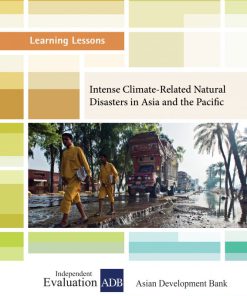Key Indicators for Asia and the Pacific 2010 1st edition by Asian Development Bank 9789292570644 9292570641
$50.00 Original price was: $50.00.$25.00Current price is: $25.00.
Authors:Asian Development Bank , Series:Management [152] , Tags:Middle Class; economy; Finance; Environment , Author sort:Bank, Asian Development , Languages:Languages:eng , Published:Published:Dec 2010 , Publisher:Asian Development Bank , Comments:Comments:The key indicators for Asia and the Pacific 2010 is the flagship annual statistical data book of the Asian Development Bank (ADB). It presents the latest available economic, financial, social, environmental, and Millennium Development Goals (MDG) indicators for regional members of ADB. Data are grouped under MDG and Regional Tables. Nontechnical explanations and brief analyses of the MDG achievements and economic, financial, social, and environmental developments are included. The regional tables are largely based on a comprehensive set of country tables. The special chapter, “The rise of Asia’s Middle Class”, looks at the growth and impacts of the region’s rapidly expanding middle class, and resulting economic and policy implications. — back cover.
Key Indicators for Asia and the Pacific 2010 1st edition by Asian Development Bank- Ebook PDF Instant Download/Delivery.9789292570644,9292570641
Full download Key Indicators for Asia and the Pacific 2010 1st edition after payment

Product details:
ISBN 10:9292570641
ISBN 13:9789292570644
Author: Asian Development Bank
Throughout Asia and the Pacific, gross domestic product growth in 2010 has recovered significantly after the economic downturn of 2008-2009. Employment grew and poverty was reduced but the quality of jobs in Asia remains inadequate. This issue of the Key Indicators highlights the crucial role of higher quality employment in economic growth and poverty reduction in Part I— Toward Higher Quality Employment in Asia—followed by statistical tables in Parts II and III with short, nontechnical commentaries on economic, financial, social, and environmental developments. Part II comprises the first set of statistical tables and commentaries, which look at the Millennium Development Goals and progress in the region toward achieving key targets. The second set of tables, which are in Part III, is grouped into seven themes providing a broader picture of economic, financial, social, and environmental developments. The aim of the publication is to provide the latest key statistics on development issues concerning Asian and Pacific economies to a wide audience including policy makers, development practitioners, government officials, researchers, students, and the general public. This year, the Asian Development Bank presents a special supplement to the Key Indicators— theFramework of Inclusive Growth Indicators, which defines inclusive growth and measures countries’ progress in ensuring that economic growth benefits all.
Key Indicators for Asia and the Pacific 2010 1st Table of contents:
Part I: Special Chapter Toward Higher Quality Employment in Asia
Introduction and Background
What is Higher Quality Employment?
Why is the Quality of Employment Important?
Patterns and Trends in the Quality of Employment
Broad Trends
Selected Experiences
Lessons in Developing Asia
Selected Interventions to Promote Higher Quality Employment
Trade and Globalization
The Role of Migration
Raising Rural Labor Productivity
Human Capital
Active Labor Legislation
Labor Unions
Social Protection
Right-To-Work and Employment Guarantees
Conclusion
References
Appendix Cross-Country Regression Models of Poverty Changes and Formalization of Employment
Part II – Millennium Development Goals
Introduction to the Millennium Development Goals
Goal 1: Eradicate Extreme Poverty and Hunger
Table 1.1 Target 1.A: Halve, between 1990 and 2015, the proportion of people whose income is less than one dollar a day
Table 1.2 Target 1.B: Achieve full and productive employment and decent work for all, including women and young people
Table 1.3 Target 1.C: Halve, between 1990 and 2015, the proportion of people who suffer from hunger
Goal 2: Achieve Universal Primary Education
Table 2.1 Target 2.A: Ensure that, by 2015, children everywhere, boys and girls alike, will be able to complete a full course of primary schooling
Goal 3: Promote Gender Equality and Empower Women
Table 3.1 Target 3.A: Eliminate gender disparity in primary and secondary education, preferably by 2005, and in all levels of education not later than 2015
Goal 4: Reduce Child Mortality
Table 4.1 Target 4.A: Reduce by two-thirds, between 1990 and 2015, the under-five mortality rate
Goal 5: Improve Maternal Health
Table 5.1 Target 5.A: Reduce by three quarters, between 1990 and 2015, the maternal mortality ratio
Table 5.2 Target 5.B: Achieve, by 2015, universal access to reproductive health
Goal 6: Combat HIV/AIDS, Malaria, and Other Diseases
Table 6.1 Target 6.A: Have halted by 2015 and begun to reverse the spread of HIV/AIDS
Table 6.2 Target 6.B: Achieve, by 2010, universal access to treatment for HIV/AIDS for all those who need it
Table 6.3 Target 6.C: Have halted by 2015 and begun to reverse the incidence of malaria and other major diseases
Goal 7: Ensure Environmental Sustainability
Table 7.1 Target 7.A: Integrate the principles of sustainable development into country policies and programmes and reverse the loss of environmental resources
Table 7.2 Target 7.B: Reduce biodiversity loss, achieving, by 2010, a significant reduction in the rate of loss
Table 7.3 Target 7.C: Halve, by 2015, the proportion of people without sustainable access to safe drinking water and basic sanitation
Table 7.4 Target 7.D: By 2020, to have achieved a significant improvement in the lives of at least 100 million slum dwellers
Goal 8: Develop a Global Partnership for Development
Table 8.1 Target 8.D: Deal comprehensively with the debt problems of developing countries through national and international measures in order to make debt sustainable in the long term
Table 8.2 Target 8.F: In cooperation with the private sector, make available the benefits of new technologies, especially information and communications
Part III – Regional Tables
Introduction to Regional Tables
People
Population
Table 1.1 Midyear Population
Table 1.2 Growth Rates in Population
Table 1.3 Migration and Urbanization
Table 1.4 Population Aged 0-14 Years
Table 1.5 Population Aged 15-64 Years
Table 1.6 Population Aged 65 Years and Over
Table 1.7 Age Dependency Ratio
Labor Force and Employment
Table 1.8 Labor Force Participation Rate
Table 1.9 Unemployment Rate
Table 1.10 Unemployment Rate of 15-24-Year-Olds
Table 1.11 Employment in Agriculture
Table 1.12 Employment in Industry
Table 1.13 Employment in Services
Poverty Indicators
Table 1.14 Poverty and Inequality
Table 1.15 Human Development Index
Social Indicators
Table 1.16 Life Expectancy at Birth
Table 1.17 Births, Deaths, and Fertility Rates
Table 1.18 Primary Education Completion Rate
Table 1.19 Adult Literacy Rate
Table 1.20 Education Resources
Table 1.21 Health Care Resources
Table 1.22 Estimated Number of Adults Living with HIV
Economy and Output
National Accounts
Table 2.1 Gross Domestic Product at PPP
Table 2.2 GDP Per Capita at PPP
Table 2.3 GNI Per Capita, Atlas Method
Table 2.4 Agriculture Value Added
Table 2.5 Industry Value Added
Table 2.6 Services Value Added
Table 2.7 Private Consumption Expenditure
Table 2.8 Government Consumption Expenditure
Table 2.9 Gross Domestic Capital Formation
Table 2.10 Exports of Goods and Services
Table 2.11 Imports of Goods and Services
Table 2.12 Gross Domestic Saving
Table 2.13 Growth Rates of Real GDP
Table 2.14 Growth Rates of Real GDP Per Capita
Table 2.15 Growth Rates of Agriculture Real Value Added
Table 2.16 Growth Rates of Industry Real Value Added
Table 2.17 Growth Rates of Services Real Value Added
Table 2.18 Growth Rates of Real Private Consumption Expenditure
Table 2.19 Growth Rates of Real Government Consumption Expenditure
Table 2.20 Growth Rates of Real Gross Domestic Capital Formation
Table 2.21 Growth Rates of Real Exports of Goods and Services
Table 2.22 Growth Rates of Real Imports of Goods and Services
Production
Table 2.23 Growth Rates of Agriculture Production Index
Table 2.24 Growth Rates of Manufacturing Production Index
Money, Finance, and Prices
Prices
Table 3.1 Growth Rates of Consumer Price Index
Table 3.2 Growth Rates of Food Consumer Price Index
Table 3.3 Growth Rates of Wholesale/Producer Price Index
Table 3.4 Growth Rates of GDP Deflator
Money and Finance
Table 3.5 Growth Rates of Money Supply (M2)
Table 3.6 Money Supply (M2)
Table 3.7 Interest Rate on Savings Deposits
Table 3.8 Interest Rate on Time Deposits of 12 Months
Table 3.9 Lending Interest Rate
Table 3.10 Yield on Short-Term Treasury Bills
Table 3.11 Domestic Credit Provided by Banking Sector
Table 3.12 Bank Nonperfoming Loans
Table 3.13 Growth Rates of Stock Market Price Index
Table 3.14 Stock Market Capitalization (US$ million)
Table 3.15 Stock Market Capitalization (percent of GDP)
Exchange Rates
Table 3.16 Official Exchange Rate
Table 3.17 Purchasing Power Parity Conversion Factor
Table 3.18 Price Level Indexes
Globalization
Balance of Payments
Table 4.1 Trade in Goods Balance
Table 4.2 Trade in Services Balance
Table 4.3 Current Account Balance
Table 4.4 Workers’ Remittances and Compensation of Employees, Receipts (US$ million)
Table 4.5 Workers’ Remittances and Compensation of Employees, Receipts (percent of GDP)
Table 4.6 Foreign Direct Investment, Net Inflows (US$ million)
Table 4.7 Foreign Direct Investment, Net Inflows (percent of GDP)
External Trade
Table 4.8 Merchandise Exports
Table 4.9 Growth Rates of Merchandise Exports
Table 4.10 Merchandise Imports
Table 4.11 Growth Rates of Merchandise Imports
Table 4.12 Trade in Goods
Table 4.13 Direction of Trade: Merchandise Exports
Table 4.14 Direction of Trade: Merchandise Imports
International Reserves
Table 4.15 International Reserves
Table 4.16 Ratio of International Reserves to Imports
Capital Flows
Table 4.17 Official Flows from All Sources to Developing Member Economies
Table 4.18 Net Private Flows from All Sources to Developing Member Economies
Table 4.19 Aggregate Net Resource Flows from All Sources to Developing Member Economies
External Indebtedness
Table 4.20 Total External Debt of Developing Member Economies (US$ million)
Table 4.21 Total External Debt of Developing Member Economies (percent of GNI)
Table 4.22 Total External Debt of Developing Member Economies (percent of exports of goods, services, and income)
Table 4.23 Total Debt Service Paid by Developing Member Economies (US$ million)
Table 4.24 Total Debt Service Paid by Developing Member Economies (percent of exports of goods, services, and income)
Tourism
Table 4.25 International Tourists (thousand)
Table 4.26 International Tourism, Receipts (US$ million)
Transport, Electricity, and Communications
Transport
Table 5.1 Road Indicators: Network
Table 5.2 Road Indicators: Vehicles
Table 5.3 Road Indicators: Safety
Table 5.4 Rail Indicators
Electricity
Table 5.5 Electricity Production and Sources
Table 5.6 Electricity Consumption and Electrification
Communications
Table 5.7 Telephone and Internet Subscriptions
Energy and Environment
Energy
Table 6.1 GDP Per Unit of Energy Use
Table 6.2 Energy Production
Table 6.3 Energy Imports, Net
Table 6.4 Energy Use
Environment
Table 6.5 Agriculture Land Use
Table 6.6 Deforestation and Pollution
Government and Governance
Government Finance
Table 7.1 Fiscal Balance
Table 7.2 Tax Revenue
Table 7.3 Total Government Revenue
Table 7.4 Total Government Expenditure
Table 7.5 Government Expenditure on Education
Table 7.6 Government Expenditure on Health
Table 7.7 Government Expenditure on Social Security and Welfare
Governance
Table 7.8 Doing Business Start-Up Indicators
Table 7.9 Corruption Perceptions Index
Part IV – Definitions
Millennium Development Goals
People also search for Key Indicators for Asia and the Pacific 2010 1st:
key indicators for asia and the pacific 2015
key indicators of developing asian and pacific countries
key indicators for asia and the pacific 2000
asia key facts
5 key global indicators












